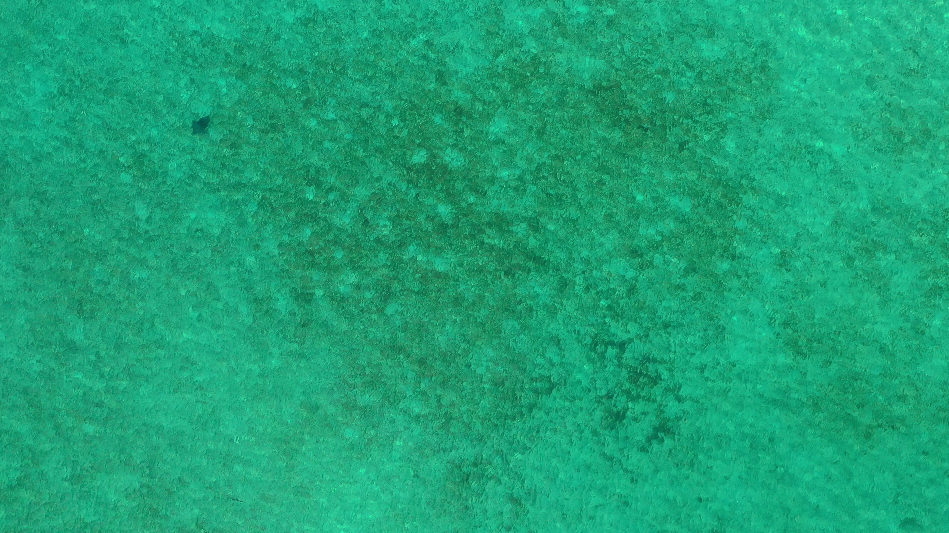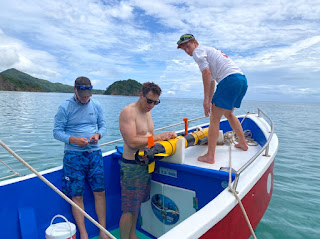Both the HMC and CSULB team have made it back to California safe and sound! Our time in Costa Rica formed lifelong friendships and memories we'll keep with us for years to come! We appreciate all of the support throughout the summer, and thank you for staying tuned in our many adventures!
ICEX 2022: Costa Rica
Ray Tracking
All of the footage from the drone surveys performed over the past two weeks can now be analyzed back in the lab. One project the team is working on is tracking eagle rays as they move through the water. With this data, the team will be able to characterize the rays' behavior quantitatively. The images below show some preliminary results from this work.
Drone surveys
Eagle rays and Pacific nurse sharks are two of the most commonly observed marine species in our drone surveys. Both of these species are considered threatened by the International Union for the Conservation of Nature (IUCN). The frequent sightings in Santa Elena Bay highlight the importance of our study site for the conservation of these species.
Acoustic Receiver Retrieval
Today, a portion of the Harvey Mudd Team assisted Mario Espinoza with the retrieval of acoustic receivers and the downloading of their information. Declan, Chris H, and Caitlyn were all able to do free dives (up to two meters!) to retrieve the devices, download the collected data, and then re-position the receivers on their underwater bases. Caitlyn was also able to do a six-meter dive for the retrieval of the fifth acoustic receiver in the set, with Mario free-diving alongside her. Pictured below are Declan and Chris H as they prep to retrieve one of the sensors.
Robot in the ocean
We had to do several repairs of the AUV (Autonomous Underwater Vehicle) and managed a few tests (see image, but are now focusing on collecting acoustic tag data for state estimation. This data will support our efforts to develop new state estimators for tracking marine life.
Welcome Caitlyn!
Turtle Catch, Tag, Release
This past week we spent Friday morning attempting to catch turtles for tagging with an acoustic transmitter to enable motion tracking within the static receiver arrays installed in the two bays of interest. One green sea turtle, was caught, measured, tagged and released. HMC student Chris Herrera and Jaden Clark (left and right) are shown releasing the turtle in the affixed image.
Shark Tagging Episode 2
This week has been highly successful with respect to shark tagging. All students were able to aid in shark tagging that took place on two separate days of catching and tagging sharks. Image below shows HMC student Yoo-Jin Hwang measuring a recently caught nurse shark after she and team we able to position the shark in a state of "tonic immobility" (upside-down).
Two types of tags were embedded in the shark: 1) an acoustic transmitter tag that emits acoustic signals at pseudo-random intervals, and 2) PIT (passive integrated transponders) tags that can be used to identify the shark if re-caught later.
Costa Rica 2022: Field Day 4
After finally having reassembled the robot the previous day, today we aimed to run a mission and collect sidescan sonar data. We began by driving the boat around Matapalito bay to log GPS coordinates in order to plan the mission. I later plotted these coordinates on top of a map of the area:
About me: Chris Herrera
My name is Christopher Herrera, and I am a rising junior at Harvey Mudd College studying computer science and math. Starting in the summer of 2021, I worked with the SotoLab analyzing a large acoustic telemetry dataset of white shark trajectories along the beaches in Santa Barbara, CA. I transitioned to the LAIR lab in January 2022 and began working on various state estimation projects. These projects include a kalman filter to estimate the distance of an acoustic pinger tag from a hydrophone using time of flight and signal strength data, as well as a particle filter to combine measurements from two hydrophones to estimate the location of the tag. Eventually this work will allow us to track tagged animals with multiple underwater autonomous vehicles (AUVs).
Costa Rica 2022: Field Day 6
About Me: Felicity Eriksson
Hi! I'm Felicity Eriksson, and I'm a rising senior majoring in marine biology at California State University, Long Beach. I am part of Dr. Lowe's Shark Lab and have been helping with juvenile white shark research since Fall 2021. I am currently collecting and using drone footage to analyze movement data on the spotted eagle ray, Aetobatus laticeps.















.jpg)






